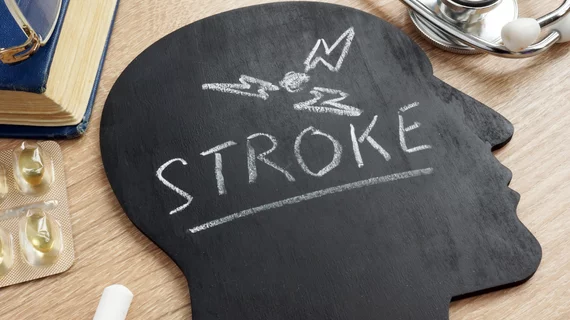MRI findings associated with poor thrombectomy outcomes after stroke
For patients who have suffered an acute ischemic stroke, white matter hyperintensity visualized on MRI before thrombectomy might be indicative of poor post-procedure clinical outcomes.
The most recent findings published in Radiology were based on the MRI brain scans of 366 patients. Researchers found that as the presence of white matter hyperintensity (WMH) volumes increased, so too did patients’ risk of poor three-month functional outcomes after endovascular thrombectomy (EVT).
“Given the increasing number of patients eligible for EVT, especially older patients with underlying chronic disorders, it is crucial to understand the association between preexisting signs of brain damage and the risk for early symptomatic intracranial hemorrhage (sICH) and poor outcome,” corresponding author Imad Derraz, from the Department of Neuroradiology at Montpellier University Medical Center in France, and co-authors explained. “Leukoaraiosis, or white matter hyperintensity (WMH), is a common neuroimaging feature of chronic cerebral small-vessel disease at brain MRI, especially in aging individuals with vascular risk factors.”
Pre-treatment MRI is used to better understand the origin of WMH before patients undergo EVT procedures after acute ischemic stroke. There is a presumed relationship between vascular origins and cognitive dysfunction, depression, increased risk for stroke, higher rate of disability and death after stroke, which suggests that patients with increased WMH burden might respond less favorably to EVT. However, data pertaining to pre-treatment WMH burden and post-treatment outcomes are conflicting.
To better understand the potential correlations, researchers analyzed the MRIs of 366 individuals who underwent EVT at a comprehensive stroke center after acute ischemic stroke. Blinded readers assessed WMH volumes and subsequent comparisons were made between the recorded volumes, sICH and three-month functional outcomes.
Based on brain imaging, a median total WMH volume of 3.61 cm was recorded. As WMH volume increased, so did patients’ modified Rankin Scale (mRS) score after adjusting for patient and clinical variables. Though poorer three-month outcomes were associated with increased WMH, researchers did not find indications that these findings were indicative of increased risks of mortality or symptomatic intracranial hemorrhage.
“We found that a high burden of WMH at pre-EVT MRI was associated with poor outcome (mRS score, >2) after treatment,” the authors noted. “For each 1.0-cm3 increase in the WMH volume, patients had an approximately 2% lower chance to be disability free at 90 days, further supporting the clinical influence of small-vessel wall alterations in this setting.”
The findings could help guide treatment decisions by giving providers a better idea of which patients could recover after EVT, the researchers suggested.
Related neuroimaging content:
PET scans spot brain abnormalities in long COVID patients
MRI scans link atypical growth of key brain structure during infancy with autism
Antithrombotic therapy does not cause intracranial hemorrhage after falls, CT scans show
'Pandemic brain': PET/MRI images reveal how COVID's impact is felt by non-infected individuals

